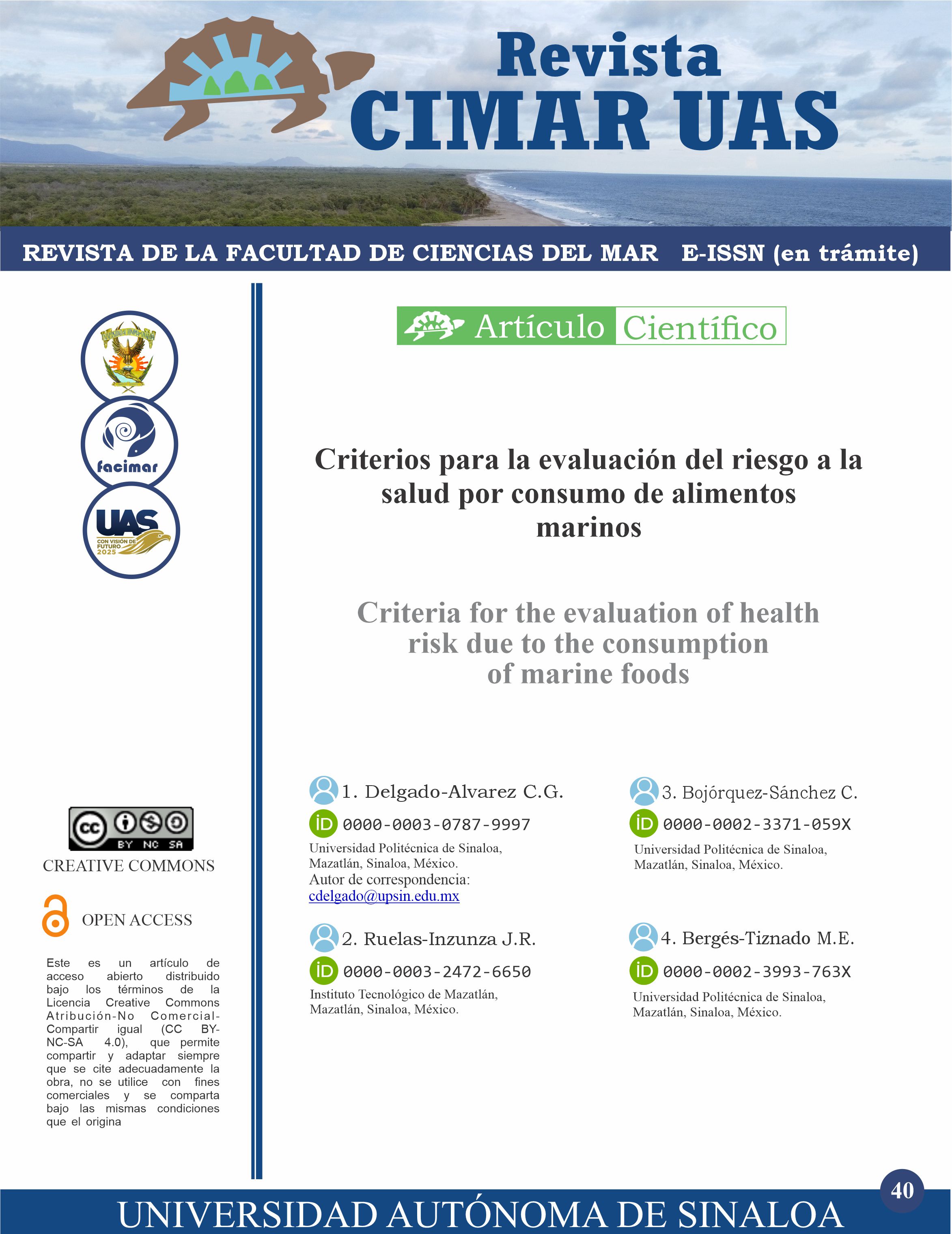Criteria for the evaluation of health risk due to the consumption of marine foods.
Keywords:
Risk assessment, pollutants, fisheries resourcesAbstract
This review provides information on the importance of assessing health risks associated with seafood consumption, particularly in estuaries and coastal lagoons. It highlights that contamination in these areas poses risks to marine life and consumers. It explains direct and indirect methods for assessing exposure to contaminants. Furthermore, it emphasizes the importance of balancing risks with the nutritional benefits of consuming fish and seafood. Additionally, specific examples of studies that assessed risks associated with seafood consumption, considering contaminants such as organic compounds, heavy metals, and others, are provided, and the results obtained in different geographical contexts are discussed. It is also established that health risk assessment for seafood consumption is essential for making informed decisions regarding human health protection and the conservation of ecosystems, considering both the risks and benefits associated with these foods. The need to continue monitoring and assessing risks in specific populations to prevent short-term and long-term harmful effects is emphasized.
Downloads
References
Castilhos Z.C., Rodrigues-Filho S., Rodrigues, A. P. C., Villas-Boas R.C., Siegel S., Veiga M. M. & Beinhoff, C. (2006). Mercury contamination in fish from gold mining areas in Indonesia and human health risk assessment. Science of the Total Environment, 368: 320-325. Doi: 10.1016/j.scitotenv.2006.01.039
Charabi Y., Choudri B. S. & Ahmed M. (2018). Ecological and human health risk assessment. Water Environment Research, 90: 1777-1791. Doi: 10.1002/wer.1382
Chen C., Wang T., Naile J., Li J., Geng J., Bi C., Hu W., Zhang X., Khim J., Feng Y., Giesy J. & Lu Y. (2011). Perfluorinated compounds in aquatic products from Bohai Bay, Tianjin, China. Human and Ecological Risk Assessment, 17: 1279–1291. Doi: 10.1080/10807039.2011.618395
Cheung K.C., Leung H.M., Kong K.Y. & Wong M.H., (2007). Residual levels of DDTs and PAHs in freshwater and marine fish from Hong Kong markets and their health risk assessment. Chemosphere, 66: 460-468. Doi: 10.1016/j.chemosphere.2006.06.008
Consejo Mexicano para la Promoción de Productos Pesqueros y Acuícolas, A.C. (COMEPESCA). (2005). http://www.comepesca.com.mx Consultada en octubre de 2012.
Jiang, Q.J., Lee T.K.M., Chen K., Wong H.L., Zheng J.S., Giesy J.P., Lo K.K.W., Yamashita N. y Lama P.K.S. (2005). Human health risk assessment of organochlorines associated with fish consumption in a coastal city in China. Environmental Pollution, 136: 155-165. Doi: 10.1016/j.envpol.2004.09.028
Newman M.C., Unger, M.A (2002). Fundamentals of Ecotoxicology: 571. En: Lewis Publishers, Boca Raton, FL.
Organización Mundial de la Salud, (2010). Human Health Risk Assessment Toolkit: Chemical Hazards. World Health Organization. https:// who.int/publications/i/item/9789241548076
Programa Internacional de Seguridad de las Sustancias Químicas. (2009) Principles for modelling dose–response for the risk assessment of chemicals. Ginebra, Organización Mundial de la Salud, International Programme on Chemical Safety. http://whqlibdoc.who.int/publications/2009/9789241572392_eng.pdf
Ruelas-Inzunza J., Páez-Osuna F., Ruiz-Fernández A.C. & Zamora-Arellano N.. (2011). Health risk associated to dietary intake of mercury in selected coastal areas of Mexico. Bulletin of Environmental Contamination and Toxicology, 86:180–188. Health Risk Associated to Dietary Intake of Mercury in Selected Coastal Areas of Mexico | Bulletin of Environmental Contamination and Toxicology (springer.com). Doi: 10.1007/s00128-011-0189-z
Soto-Jiménez M.F., Amezcua F. y González-Ledesma R. (2010). Nonessential metals in striped marlin and Indo-Pacific sailfish in the Southeast Gulf of California, Mexico: Concentration and assessment of human health risk. Archives of Environmental Contamination and Toxicology, 58: 810-818. Doi: 10.1007/s00244-009-9452-2
Storelli M.M. (2008). Potential human health risks from metals (Hg, Cd, and Pb) and polychlorinated biphenyls (PCBs) via seafood consumption: Estimation of target hazard quotients (THQs) and toxic equivalents (TEQs). Food Chemistry and Toxicology, 46: 2782-2788. Doi: 10.1016/j.fct.2008.05.011
United States Environmental Protection Agency. (2000). Fish sampling and analysis. En: Guidance for assessing chemical contaminant, data for use in fish advisories, vol. 1. Office of Water, Washington, DC.
United States Environmental Protection Agency. (1989). Human health evaluation manual (Parte A). En: Risk assessment guidance for superfund, vol. 1. Washington, DC.
United States Environmental Protection Agency. (1997). Mercury study report. En: Health Effects of Mercury and Mercury Compounds, vol. V. Washington, DC.
United States Environmental Protection Agency. (1997). Mercury study report to congress. Office of Research and Development. Washington, DC.
United States Environmental Protection Agency. (2000). Handbook for non-cancer health effects evaluation. Washington, DC.
United States Environmental Protection Agency. (2000). Risk-based concentration table. Environmental Protection Agency. Washington, DC.
Wei, X., Huang Y., Wong M., Giesy J. & Wong C. (2011). Assessment of risk to humans of bisphenol A in marine and freshwater fish from Pearl River. Chemosphere, 85: 122–128. Doi: 10.1016/j.chemosphere.2011.05.038
Zhao Y., Wan H., Law A., Wei X., Huang Y., Giesy J., Wong M. & Wong C. (2011). Risk assessment for human consumption of perfluorinated compound-contaminated freshwater and marine fish from Hong Kong and Xiamen. Chemosphere, 85: 277–283. Doi: 10.1016/j.chemosphere.2011.06.002

Downloads
Published
Data Availability Statement
As of septiembre 30, the references and links of the article were available for verification.

 Cada manuscrito está bajo la licencia Atribución-NoComercial-SinDerivadas 4.0 Internacional (CC BY-NC-ND 4.0). Puedes consultar los términos de la licencia en el siguiente enlace:
Cada manuscrito está bajo la licencia Atribución-NoComercial-SinDerivadas 4.0 Internacional (CC BY-NC-ND 4.0). Puedes consultar los términos de la licencia en el siguiente enlace: 